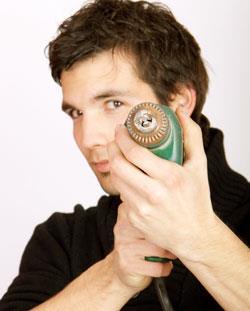Thursday, September 19, 2013
The do-it-yourself trend continues to grow throughout South Africa as DIY enthusiasts realise the benefits of having the knowledge and basic skills to tackle home improvement, maintenance and repair jobs around the house.

A drill/driver is a screwdriver and drill combination.
DIY is gaining more acceptance as a way to save money and be more empowered. But doing-it-yourself requires more than a half-hearted approach if you want the job done right - it requires having the knowledge and tools to successfully complete your projects.
Here’s what every DIYer needs to know.
The basics
Homeowners who prefer to do things themselves need to start with the basics, which include a tape measure, craft knife, quick clamps, a folding of freestanding workbench and safety gear such as dust masks, gloves and safety glasses.
The power tools
What is a drill/driver?
A drill/driver is a screwdriver and drill combination. With two settings, screw control and drill, you can use a drill/driver as a screwdriver for routine tasks in and around the home, or use the drill function, which converts this hand tool into a power tool.

The sander can be used on a number of indoor and outdoor home projects.
On this setting, homeowners can drill into timber and board, as well as plaster, tiles, soft steel, and plastic.
What model should I buy?
Depending on how much you want to spend and how often you’ll be using your drill/driver, the Bosch PSR 14.4 LI2 is an entry-level drill/driver which is still powerful enough for basic DIY projects.
The Bosch PSR 18 LI2 is even more powerful and recommended for DIYers with plenty of projects to do.
The new Bosch PSB combi drill adds even more functionality to the drill/driver by switching to impact drill mode, making it possible to drill into masonry without having to change drills. Having said that, the portable combi drill is considerably heavier than the standard drill/driver range and I wouldn't recommend this for everyday DIY projects.

A jigsaw is a handy power tool for cutting corners and curves, adding detail and even for cutting wood to size.
Why do I need a sander?
You will definitely need a sander if you plan to make your own DIY projects. But a sander comes in handy in many other ways as well. For any painting projects, indoors or outdoors, owning a sander means you can finish projects professionally.
What model should I buy?
An all-round sander, the Bosch PSS 200 AC can be used for most sanding projects. For a professional finish on furniture projects we recommend the Bosch PEX 220 A or PEX 300 AE random orbit sanders.
When will I use a jigsaw?
While you can have all your timber and board cut to size at your local Builders Warehouse, bear in mind that they don't cut curves or shapes other than squares and rectangles. A jigsaw is a handy power tool for cutting corners and curves, adding detail and even for cutting wood to size.
Additionally, you will often find that timber and board is not cut to exact size and may need a bit of trimming here and there.
What model should I buy?
The Bosch PST 650 is more than adequate for home DIY projects. It's powerful enough to cut through soft and medium hardwood and board products.
If you are planning outdoor DIY projects or won't have access to power, then the Bosch PST 18 LI lithium-ion battery powered jigsaw is ideal.
Article courtesy of www.home-dzine.co.za

Home - Dzine
Your online source of ideas and inspiration.